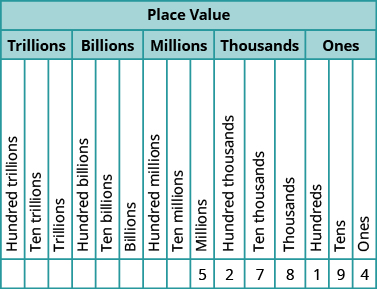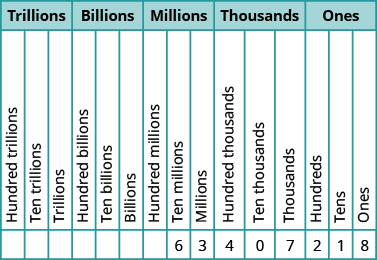| << Chapter < Page | Chapter >> Page > |
A more thorough introduction to the topics covered in this section can be found in Prealgebra in the chapters Whole Numbers and The Language of Algebra .
As we begin our study of elementary algebra, we need to refresh some of our skills and vocabulary. This chapter will focus on whole numbers, integers, fractions, decimals, and real numbers. We will also begin our use of algebraic notation and vocabulary.
The most basic numbers used in algebra are the numbers we use to count objects in our world: 1, 2, 3, 4, and so on. These are called the counting number s . Counting numbers are also called natural numbers . If we add zero to the counting numbers, we get the set of whole number s .
Counting Numbers: 1, 2, 3, …
Whole Numbers: 0, 1, 2, 3, …
The notation “…” is called ellipsis and means “and so on,” or that the pattern continues endlessly.
We can visualize counting numbers and whole numbers on a number line (see [link] ).

Our number system is called a place value system, because the value of a digit depends on its position in a number. [link] shows the place values . The place values are separated into groups of three, which are called periods. The periods are ones, thousands, millions, billions, trillions , and so on. In a written number, commas separate the periods.

In the number 63,407,218, find the place value of each digit:
Place the number in the place value chart:

ⓐ The 7 is in the thousands place.
ⓑ The 0 is in the ten thousands place.
ⓒ The 1 is in the tens place.
ⓓ The 6 is in the ten-millions place.
ⓔ The 3 is in the millions place.
For the number 27,493,615, find the place value of each digit:
ⓐ 2 ⓑ 1 ⓒ 4 ⓓ 7 ⓔ 5
ⓐ ten millions ⓑ tens ⓒ hundred thousands ⓓ millions ⓔ ones
For the number 519,711,641,328, find the place value of each digit:
ⓐ 9 ⓑ 4 ⓒ 2 ⓓ 6 ⓔ 7
ⓐ billions ⓑ ten thousands ⓒ tens ⓓ hundred thousands ⓔ hundred millions
When you write a check, you write out the number in words as well as in digits. To write a number in words, write the number in each period, followed by the name of the period, without the s at the end. Start at the left, where the periods have the largest value. The ones period is not named. The commas separate the periods, so wherever there is a comma in the number, put a comma between the words (see [link] ). The number 74,218,369 is written as seventy-four million, two hundred eighteen thousand, three hundred sixty-nine.

Notification Switch
Would you like to follow the 'Elementary algebra' conversation and receive update notifications?